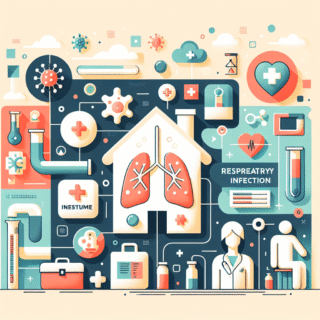
More Family/Primary Care Articles
How to Treat Respiratory Infection at Home?

Most mild respiratory infections can be managed at home with careful self-care, and a clear plan that treats respiratory symptoms while preventing spread to others. This guide explains practical steps to ease coughing, congestion, sore throat and mild fever, when to seek medical help, and how to support recovery safely. If you’re wondering how to treat a respiratory infection at home, read on for evidence-based strategies and simple remedies that prioritize rest, hydration and symptom relief.
Home Care That Treats Respiratory Symptoms
Understanding basic measures for how to treat respiratory infection at home helps you feel better faster and reduces the risk of complications. Begin by assessing symptom severity: high fever, difficulty breathing, chest pain, blue lips or confusion require prompt medical attention. For mild-to-moderate symptoms, most people can manage their illness at home using rest, fluids, and targeted symptom control.
Rest, hydration, and nutrition
Rest is the cornerstone of recovery. Sleep and reduced activity give the immune system resources to fight infection. Stay well hydrated with water, broths, and warm herbal teas; clear fluids thin mucus and soothe irritated throats. Eat nutrient-rich foods as tolerated—soups, fruits, and simple proteins support immune function even when appetite is low.
Control symptoms safely
Over-the-counter medications can relieve fever, aches and congestion. Use acetaminophen or ibuprofen for fever and pain following package directions. Saline nasal rinses and steam inhalation can help with nasal congestion and sinus pressure. A humidifier in your bedroom eases dryness and coughing at night. Honey (for adults and children over one year) can soothe coughs; avoid honey in infants.
Practical steps to treat respiratory infection at home
Use simple hygiene and comfort measures to reduce symptom burden and limit spread. These steps explain best practices for how to treat respiratory infection at home without unnecessary antibiotics or interventions.
- Isolate within the home when possible: stay in a separate room and use a separate bathroom if available, especially in the first few days of symptoms.
- Wear a mask when you must be near others, and practice frequent handwashing with soap and water for at least 20 seconds.
- Clean frequently touched surfaces daily with household disinfectants.
- Monitor temperature and breathing; record changes so you can report them if you contact a clinician.
- Avoid smoking and secondhand smoke, which worsen respiratory symptoms and delay recovery.
When to get medical care
If symptoms worsen or you notice red flags—shortness of breath, persistent high fever, chest pain, persistent vomiting, or signs of dehydration—seek medical evaluation. Older adults, people with chronic heart or lung disease, diabetes, weakened immune systems, or young infants may require earlier assessment. If antibiotics are recommended, they should only be used when a bacterial cause is identified or strongly suspected; most common colds and many bronchitis cases are viral and do not benefit from antibiotics.
For more background on the types and causes of respiratory infections, see this summary from a trusted health resource: Respiratory tract infection — Wikipedia.
Supportive practices and complementary remedies
Many complementary measures offer comfort though evidence varies. These include warm saline gargles for throat pain, menthol or eucalyptus rubs to ease congestion, and steam inhalation for temporary relief. Herbal teas with ginger, lemon, and honey can provide hydration and comfort. Always check interactions if you use herbal supplements, and avoid unproven or unsafe remedies.
If you’re unsure about how to treat respiratory infection at home for a specific person—such as a child, pregnant person, or someone with chronic illness—contact a healthcare provider for tailored advice. For regularly updated practical guides and health features, visit our latest editions.
- Prioritize rest, hydration, and symptom control with safe OTC medications.
- Use isolation and hygiene to prevent spread; seek care for warning signs.
- Most mild respiratory infections are viral—antibiotics are usually not needed.
FAQ: Can I use antibiotics at home for a respiratory infection?
Antibiotics treat bacterial infections, not viruses. Many respiratory infections are viral, so antibiotics offer no benefit and can cause side effects. A clinician will decide if antibiotics are appropriate based on symptoms, exam findings, and sometimes tests.
FAQ: How long will symptoms last if I treat respiratory infection at home?
Duration varies by cause: common colds typically improve in 7–10 days, while coughs can persist for several weeks. Influenza may cause more intense symptoms for a few days. If symptoms do not improve or worsen after a week, contact your healthcare provider.
FAQ: When should I seek emergency care?
Seek emergency help for severe shortness of breath, difficulty breathing, persistent chest pain, sudden confusion, or bluish lips or face. These are signs of potentially serious illness and require immediate evaluation.
Other Articles You May Find of Interest...
- Drafting Personal Health Goals – What You Should Not Skip
- Can Low Blood Pressure Cause Headaches? Exploring the Connection
- Two Sides of Prevention: How CPR Skills and STD Awareness Strengthen Community Health
- Top Healthcare Challenges Faced by Hispanic Communities in Texas
- Best Affordable Primary Care Providers in Texas
- The benefits of telehealth: making healthcare easier for Australians
- Essential Health Knowledge Every Australian Family Should Have














